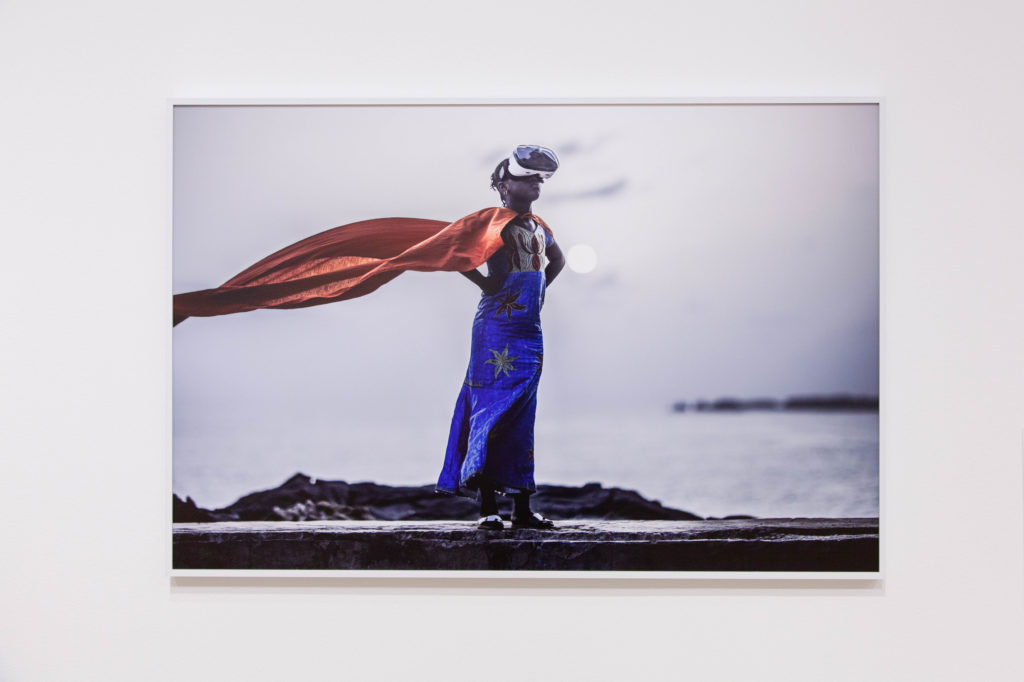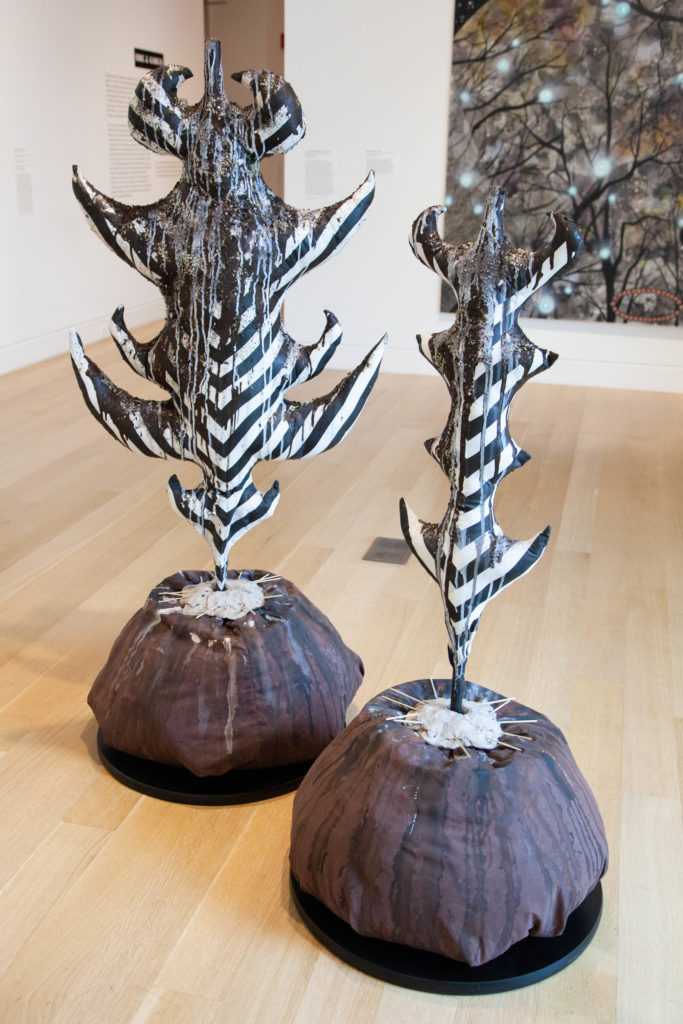
Self-care, in its most original definition, is not only about taking care of oneself and one’s communities’ mental, physical, and psychological health; it is about holding all parties accountable.1 Self-care, appropriated into capitalist metric, now results in consuming nice things and conducting erasure of historic healing cultural practices of communities of color—notably those held by Indigenous and Black people. Although the 60s “New Age” beliefs were to herald the literal “dawn” of a new time, what resulted forty years later was a mass popularization of turmeric tea lattes and indigenous practices, such as burning Palo Santo, while the deforestation of this southern Ecuadorian tree has strained its use in communities’ ritual practices.2
Inside the galleries of the DePaul Art Museum (DPAM), the exhibition New Age, New Age: Strategies of Survival, provides a particular focus on how LGBTQIA*, Black women, and artists of color use practices of healing and preservation as tools of resistance and persistence facing the continued onslaught of racism, sexism and environmental instability. As DPAM curator Julie Rodrigues Widholm explains, “We are in an era of skyrocketing depression, anxiety, and social divisions. People are seeking ways to find meaning, center themselves and connect with each other ranging from grassroots internet brujas and tarot readers to Gwyneth Paltrow’s Goop and meditation workshops for CEOs…”3 The exhibition includes installations of hybrid electronic and natural elements such as plant leaves and gems by Rhonda Wheatley, the Advanced Potions (2019) apothecary kit by Matt Marris, and multimedia works that visualize futurist matriarchal communities by Saya Woolfalk.
One such meaning is sought in a figure that emerges from an earth-toned red, orange, and yellow vase. Wearing a similarly-toned cloth, this is the late Marva Lee Pitchford-Jolly’s ceramic Spirit Woman (2007).The eyes of the figure bear witness to a legacy framed by collective preservation. (The eyes of Pitchford-Jolly’s figure are not hidden.) Pitchford-Jolly, as a professor at Chicago State University and an instrumental figure in the founding of Sapphire & Crystals, a group of Black female artists in Chicago, was regarded for her commitment to empowering young artists.4 Spirit Woman exemplifies Pitchford-Jolly’s use of clay as a means to imagine the divine feminine and other-worldly figures.5 Her clay figures are inspired by her memories of growing up on her family’s farm in Crenshaw, Mississippi, as she said, “My sense of beauty comes out of Mississippi.”6 Through the medium of clay, Pitchford-Jolly molds objects that connect her, and in turn us, to our pasts and present. This is particularly salient for Black women, women of color, and queer people. What does it mean to honor and celebrate our histories when culturally we have not excluded and othered from mainstream rendition of history and place-making? How do we fortify, mend, or heal when all of our waking hours are stolen for work in systems designed not for but against us?

This conundrum is taken to account through tall black-and-white striped soft sculptures by D. Denenge Duyst-Akpem in Wan Chuku’s Mystical Yam Mounds (2018). Duyst-Akpem is “an Afro-Futurist space sculptor,” performance artist, writer, and educator who teaches at the School of the Art Institute of Chicago.7 8 Originally conceived as a part of a large-scale installation at Wákàtí: Time Shapes African Art exhibition at Oklahoma State University Museum of Art, the sculptures are modeled after the stems of yams growing up from the mounds.”910 On the stems a shiny black pearlescent paint has been dipped, connecting the stem to the source of the plant—as yams produce underground. The reference of yams comes from Duyst-Akpem’s background, as she says, “Tiv people are known as the yam farmers of Nigeria-African yams, not sweet potatoes—and where we live is a very verdant, rich farmland.”11 Additionally, the dazzle camouflage of the sculpture signifies protection and shares a visual connection to “Tiv traditional loom-woven textile ‘anger’ (pronounced “ahn-gair”), a gift given at achievement or family blessing.”12 Beyond fulfilling basic necessities, yams are life-giving force, a property Duyst-Akpem honors by listing “libations, breath, and incantation” as the sculpture’s materials—only while honoring our histories and collectivities can we move forward. The rhizomatic metaphor of the yam tuber growing underground is an apt parallel for what “New Age” can really mean.13 By concealing oneself from the watchful eyes of capitalism, connection, and in turn, sprouting and therefore surfacing, can we share our growth with others. As Duyst-Akpem’s sculpture honors this plant, so too may we emerge as firm and well-rounded beings.
Creating an adjacent backdrop for Duyst-Akpem’s work, Michiko Itatani’s Brown Dwarf (2017) painting from the Cosmic Encounter series features, a reoccurring motif in her work, glowing rings of light akin to multidimensional portals.14 In the painting, large trees painted with Sumi ink and oil paint engulf the viewer in a celestial blanket of twinkling stars. Within the scene, the stars have come down to rest on the Earth’s trees, this is where light is living, and so are the trees, they breathe, and share life-force. The symbiosis in this composition is a continued exploration of her previous works, such as the Starry Night Encounter, and the philosophy of ichi-go ichi-e, a Japanese Zen Buddhist term for once-in-a-lifetime opportunity of meeting with another being because we may not see each other again.15 Inspired by writing stories, and transporting elements of the solar eclipse to Earth, Itatani’s painting entrances our minds. There is an indescribable pleasure in being aware of our smallness within the larger cosmic continuum and living in the “now” by cherishing the time we spend with our loved ones.
While the artists featured in New Age demonstrate strategies of healing, solidarity, and community-building, for Black, brown, and queer communities, these are in fact, not new. These strategies of survival, long used by marginalized communities, are now required to move forward in a fascist world. This exhibition highlights that historically, queer, Black communities, and communities of color have had (and continue) to work harder to not only survive, but thrive. Instead of “strategies of survival” in New Age, we are witnessing strategies of continuous revival.
New Age, New Age: Strategies of Survival runs at the DePaul Art Museum until August 11, 2019.
- Dockray, Heather. “Self-care Isn’t Enough. We Need Community Care to Thrive.” Mashable. May 24, 2019. Accessed July 31, 2019. https://mashable.com/article/community-care-versus-self-care/.
- Nature and Culture International. “The Palo Santo Project.” Nature and Culture International. Accessed July 31, 2019. https://natureandculture.org/our-process/sustainable-development/the-palo-santo-project/.
- Widholm, Julie Rodrigues. “Press Releases: News: Newsroom: DePaul University, Chicago.” Press Releases | News | Newsroom | DePaul University, Chicago. April 2, 2019. Accessed July 31, 2019. https://resources.depaul.edu/newsroom/news/press-releases/Pages/new-age-DPAM-2019.aspx.
- Woman Made Gallery. “Marva Pitchford Jolly.” Woman Made Gallery – Ensuring the Equal Placement of Women’s Art in the World. Accessed July 31, 2019. https://womanmade.org/artwork/marva-pitchford-jolly-2/.
- The History Makers. “Marva Lee Pitchford-Jolly’s Biography.” The History Makers. Accessed July 31, 2019. https://www.thehistorymakers.org/biography/marva-lee-pitchford-jolly-41.
- WFMT. “Marva Lee Pitchford-Jolly: Art & Design in Chicago.” WTTW Chicago. October 12, 2018. Accessed July 31, 2019. https://interactive.wttw.com/art-design-chicago/marva-lee-pitchford-jolly.
- School of the Art Institute of Chicago. “D. Denenge Duyst-Akpem and the Future of Afrofuturism.” School of the Art Institute of Chicago. Accessed July 31, 2019. http://www.saic.edu/news/d-denenge-duyst-akpem-and-future-afrofuturism.
- Walkowicz, Dr. Lucianne. “Decolonizing Mars: D. Denenge Duyst Akpem.” Decolonizing Mars. 2017. Accessed July 31, 2019. https://www.decolonizemars.org/d-denenge-duyst-akpem.
- Sixty Inches From Center. “Chicago Archives Artists Project: Interview with D. Denenge Duyst-Akpem.” Sixty Inches From Center. February 16, 2018. Accessed July 31, 2019. http://sixtyinchesfromcenter.org/denenge-chicago-archives-artists-project-interview/.
- Wakati: Time Shapes African Art Playlist. Produced by OSU MuseumofArt. Performed by Denege Akpem, AKIRASH, and Moyo Okediji. Wakati: Time Shapes African Art. December 8, 2015. Accessed July 29, 2019. https://www.youtube.com/playlist?list=PLZKpw7kWVm1m1uDSwAVSVG3pe1zZZ-18v.
- Sixty Inches From Center. “Chicago Archives Artists Project: Interview with D. Denenge Duyst-Akpem.” Sixty Inches From Center. February 16, 2018. Accessed July 31, 2019. http://sixtyinchesfromcenter.org/denenge-chicago-archives-artists-project-interview/.
- Duyst-Akpem, D. Denenge. “Denenge.” Denenge. 2019. Accessed July 31, 2019. https://denenge.net/camo-coat/.
- GrowingAndGathering.com. “Yams.” Growing And Gathering. 2014. Accessed July 31, 2019. https://growingandgathering.com/yams/.
- Lewis & Clark Community College. “Celestial Narratives.” Lc.edu. Accessed July 31, 2019. https://www.lc.edu/michikoitatani/.
- Kina, Laura. Michiko Itatani: Painting the Cosmic Novel – Virtual Asian-American Artists Museum. Accessed July 31, 2019. https://vaaam.tome.press/chapter/michiko-itatani-painting-the-cosmic-novel/.